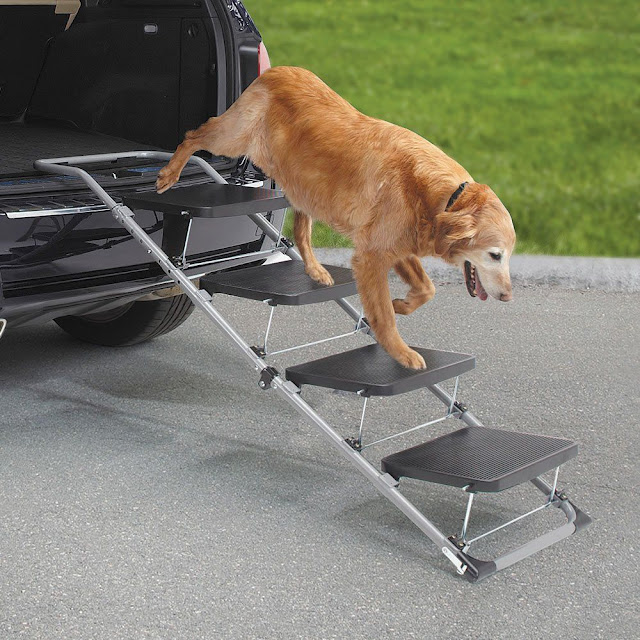Selecting the Ideal Pet Ramp: An In-Depth Handbook
Welcome to our comprehensive guide on choosing the best pet ramp for your furry friend. We understand that your pet's safety and comfort are of utmost importance to you, and finding the right ramp can make a world of difference in their daily lives.
In this guide, we will walk you through everything you need to know to make an informed decision when selecting a pet ramp online. From understanding your pet's needs to the different types of ramps available, we've got you covered. So, let's dive in!
Understanding Your Pet's Needs:
Before delving into the world of pet ramps, it's crucial to understand why they are necessary for your pet. Various factors, such as age, size, breed, and health condition, can influence the need for a pet ramp. For instance, older pets may have joint problems or arthritis, making it difficult for them to jump onto furniture or climb stairs. Similarly, smaller dog breeds may struggle to reach higher surfaces due to their size. By using a pet ramp, you can prevent injuries and ensure your pet's comfort while allowing them to maintain their independence.
Types of Pet Ramps Available:
Now that we understand the importance of a pet ramp, let's explore the different types available in the market:
1. Folding Ramps:
Folding ramps are designed to be easily folded and unfolded, making them highly portable. They are usually made of lightweight materials such as aluminum or plastic, allowing for easy transportation. These ramps are ideal for pet owners who frequently travel with their furry friends or require a ramp that can be easily stored when not in use. However, it's essential to ensure that the folding mechanism is sturdy and secure to prevent any accidents during use.
2. Telescoping Ramps:
Telescoping ramps are adjustable in length, allowing you to customize the ramp to suit your pet's needs. These ramps often feature a sliding mechanism that extends or retracts the ramp to the desired size. Telescoping ramps are versatile and can be used for a variety of purposes, such as accessing cars, beds, or stairs. However, it's important to choose a ramp with a smooth sliding mechanism to prevent any injuries to your pet's paws.
3. Built-in Ramps:
Built-in ramps are permanent fixtures within your home or vehicle. They are often custom-designed to seamlessly blend with the existing structure, providing a safe and convenient access point for your pet. These ramps are commonly found in homes with aging pets or vehicles adapted for pet transportation. While built-in ramps offer excellent stability and ease of use, they require professional installation and may not be suitable for those who frequently change their living or travel arrangements.
Each type of pet ramp has its own set of pros and cons, so it's crucial to consider your pet's specific needs and your lifestyle before making a decision.
Considerations When Choosing a Pet Ramp:
Choosing the right pet ramp involves considering several factors. Here are the key considerations you should keep in mind:
1. Size and Weight Capacity:
It's essential to select a pet ramp that can support your pet's weight. Larger dog breeds may require heavy-duty ramps with a higher weight capacity, while smaller pets may be comfortable with lighter ramps. Ensuring the ramp's weight capacity aligns with your pet's weight will provide the necessary support and prevent any accidents or injuries.
2. Portability and Storage:
If you plan on traveling frequently with your pet or need a ramp that can be easily stored when not in use, portability becomes a crucial factor. Look for ramps that are lightweight, foldable, or have a compact design. These features will make it easier for you to transport the ramp or store it in limited spaces like car trunks or closets.
3. Safety Features:
The safety of your pet should be a top priority when choosing a ramp. Look for ramps that offer non-slip surfaces to ensure your pet's paws can grip the ramp securely. Sturdy construction is also essential to provide stability during use. Additionally, side rails can provide added security, preventing your pet from accidentally falling off the ramp.
4. Ease of Use:
Consider the ease of setup and use when selecting a pet ramp. Look for ramps with adjustable height options, allowing you to customize the ramp to various surfaces or furniture heights. A user-friendly design, such as ramps with grip attachments or handles, can make it easier for you to assist your pet in using the ramp.
Maintenance Tips:
To ensure the longevity of your pet ramp, it's essential to follow proper maintenance practices. Here are some tips to keep your pet ramp in top condition:
- Regularly clean the ramp using mild detergent and water. Avoid using harsh chemicals or abrasive materials that could damage the ramp's surface.
- Inspect the ramp for any loose hinges, damaged surfaces, or worn-out grips. Repair or replace any damaged parts promptly to prevent accidents.
- Store the ramp in a dry and secure location when not in use to protect it from weather elements or potential damage.
By following these maintenance tips, you can ensure that your pet ramp remains safe and functional for years to come.
Conclusion:
Choosing the best pet ramp for your furry friend is a decision that requires careful consideration. By understanding your pet's needs, exploring the different types of ramps available, and considering crucial factors such as size, portability, safety features, and ease of use, you can make an informed choice. We hope this comprehensive guide has provided you with the necessary information to select a pet ramp that suits your pet's needs and enhances their daily life. Remember, your pet's safety and comfort should be at the forefront of your decision-making process. Happy ramp shopping!




Comments
Post a Comment